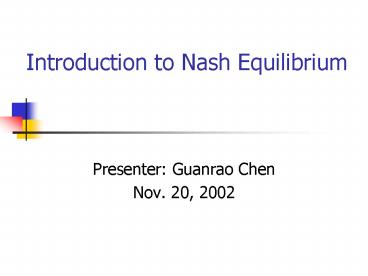Introduction to Nash Equilibrium - PowerPoint PPT Presentation
1 / 23
Title:
Introduction to Nash Equilibrium
Description:
Multiple Equilibria I - Simple Coordination Games ... 'Equilibrium points in N-Person Games', 1950, Proceedings of NAS. ... Cooperative Games', 1951, Annals ... – PowerPoint PPT presentation
Number of Views:122
Avg rating:3.0/5.0
Title: Introduction to Nash Equilibrium
1
Introduction to Nash Equilibrium
- Presenter Guanrao Chen
- Nov. 20, 2002
2
Outline
- Definition of Nash Equilibrium (NE)
- Games of Unique NE
- Games of Multiple NE
- Interpretations of NE
- Reference
3
Definition of Nash Equilibrium
- Pure strategy NE
- A pure strategy NE is strict if
- -gtNeither player can increase his expected payoff
by unilaterally changing his strategy
4
Games of Unique NEExample1
- Prisoners Dilemma
- Unique NE (D,D)
5
Games of Unique NEExample2
- Unique NE (U,L)
6
Games of Unique NEExample2
- Uniqueness
- 1) Check each other strategy profile
- 2)
- Proposition If is a pure strategy NE
of G then
7
Games of Unique NEExample3
- Cournot game with linear demand and constant
marginal cost - Unique NE intersection of the two BR functions
8
Games of Unique NEExample3
- Proof is a NE iff. for all i.
- -gtAny NE has to lie on the best response function
of both players. - Best response functions
- gt
9
Games of Unique NEExample4
- Bertrand Competition
- 1) Positive price
- 2) Constant marginal cost
- 3) Demand curve
- 4) Assume
- Unique NE
10
Games of Unique NEExample4
- Proof 1) is a NE.
- 2) Uniqueness
- Case 1
- Case 2
- Case 3
- If deviate
- Profit before
- Profit after
- Gain
11
Multiple Equilibria I - Simple Coordination Games
- The problem How to select from different
equilibria - New-York Game
- Two NEs (E,E) and (C,C)
12
Multiple Equilibria I - Simple Coordination Games
- Voting Game 3 players, 3 alternatives, if 1-1-1,
alternative A is retained - Preferences
- Has several NEs (A,A,A),(B,B,B),(C,C,C),(A,B,A),(
A,C,C).. - Informal proof
13
Multiple Equilibria Focal Point
- A focal point is a NE which stands out from the
set of NEs. - Knowledge information which is not part of the
formal description of game. - Example Drive on the right
14
Multiple Equilibria II - Battle of the Sexes
15
Multiple Equilibria II - Battle of the Sexes
- Class Experiment
- You are playing the battle of the sexes. You are
player2. Player 1 will make his choice first but
you will not know what that move was until you
make your own. What will you play?
- 18/25 men vs. 6 out of 11 women
- Men are more aggressive creatures
16
Multiple Equilibria II - Battle of the Sexes
- Class Experiment
- You are player 1. Player 2 makes the first move
and chooses an action. You cannot observe her
action until you have chosen your own action. - Which action will you choose?
- 17/25 choose the less desirable action(O).
- Players seem to believe that player 1 has an
advantage by moving first, and they are more
likely to cave in.
17
Multiple Equilibria II - Battle of the Sexes
- Class Experiment
- You are player 1. Before the game, your opponent
(player 2) made an announcement. Her announcement
was I will play O. You could not make a
counter-announcement. - What will you play ?
- 35/36 chose the less desirable action.
- Announcement strengthens beliefs that the other
player will choose O.
18
Multiple Equilibria II - Battle of the Sexes
- Class Experiment
- You are player 1. Before the game, player 2 (the
wife) had an opportunity to make a short
announcement. Player 2 choose to remain silent. - What will you play?
- lt12 choose the less desirable action.
- Silence weakness??
19
Multiple Equilibria III - Coordination Risk
Dominance
- Given the following game
- What action, A or B, will you choose?
20
Multiple Equilibria III - Coordination Risk
Dominance
- Observation
- 1) Two NEs (A,A) and (B,B). (A,A) seems better
than (B,B). - 2) BUT (B,B) is more frequently selected.
- Risk-dominance u(A)-3 while u(B)7.5
21
Interpretations of NE
- In NE, players have precise beliefs about the
play of other players. - Where do these beliefs come from?
22
Interpretations of NE
- 1) Play Prescription
- 2) Preplay communication
- 3) Rational Introspection
- 4) Focal Point
- 5) Learning
- 6) Evolution
- Remarks
23
References
- "Equilibrium points in N-Person Games", 1950,
Proceedings of NAS. - "The Bargaining Problem", 1950, Econometrica.
- "A Simple Three-Person Poker Game", with L.S.
Shapley, 1950, Annals of Mathematical Statistics.
- "Non-Cooperative Games", 1951, Annals of
Mathematics. - "Two-Person Cooperative Games", 1953,
Econometrica.































